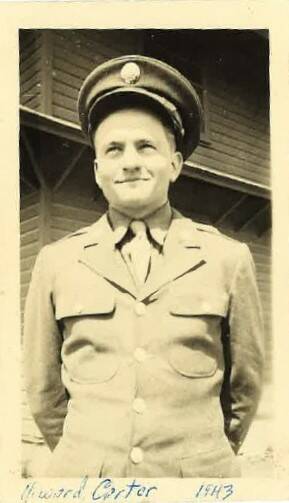Anyone who visits the Montesano Senior Center bright and early in the morning during the typical work week is bound to come across 99-year-old Montesano resident Howard Carter, drinking coffee with his wife of more than 76 years, Beverly, and perhaps some of their friends chatting or playing games.
“Every day we come in for coffee, we play a game where we put a coin in a cup and whoever’s coin gets drawn pays for all of our coffees,” Howard said with a laugh.
Behind what most people see as a joyous man living his days in retirement, is a library of history. Howard is a World War II veteran. His eyesight isn’t too great anymore, but the tone of his voice is mesmerizing as he remembers pivotal happenings from another time and place that younger generations have trouble envisioning.
Howard was born in Wynoochee Valley, a steady man who enjoyed working with his hands and hunting in the woods. He graduated from Montesano High School in 1941, was drafted into the Army in 1943, and headed to basic training in Fort Eustis, Virginia, after receiving his uniform and serial number at Fort Lewis, long before it was renamed Joint Base Lewis-McCord. He also made stops at Camp Davis, North Carolina, and a military base in Texas where he worked his way up to the rank of Tech Sergeant working on aircraft and tanks.
Nearly a year after he was first drafted, Howard boarded a ship to Scotland, and after the events of D-Day, would eventually head to the battlefield typically stationed four miles from the frontlines of the Allied Forces invasion into Nazi Germany. Because of his experience at home and in basic training working with vehicles, Howard’s main job was as a mechanic in the war. He and others would scour the roads post-battle to fix and deliver tanks, as well as find machinery to salvage, often at the risk of their own lives.
“My first order I was told to take the tank and go toward the front on this road, we were given a strip map, and I was going to meet a crew of five that had lost their tank. I went down the road, met them, I climbed out, they took the tank, and I’m walking back. That was fine in the daylight but try it at night,” Howard said.
Although he may not have been on the front lines, he supported those who were, and experienced enough gunfire to recollect about nearly 80 years later.
“I don’t know where we were at, but we were on an open stretch of road, nothing but light poles, and I looked up at a German Messerschmitt flying around. I told my partner, Joey Burt, if it turns, we’re leaving,” Howard said. “Well, it saw us and turned back right at us, and I told Burt to jump, we’re going 30 miles an hour. We both jumped and let the Jeep keep moving down the road. I wish you could have seen that Jeep. It overshot the engine and shot through the windshield, steering wheel, and seats. We weren’t hurt too bad, and the Jeep was still running.”
Howard was no doubt experiencing adrenaline from the ordeal. When an ambulance arrived to help the men shortly afterward, Howard had suffered a broken kneecap and a sprained ankle, which they bounded tightly so he could continue his work. While Howard’s first run-in with gunfire felt straight out of an action movie, his second run-in detailed what war truly was.
“We got caught one other time when we had run across a breakdown. In case anything happened, Burt and I would always look for a hiding spot, never together. Well, I had found a nice foxhole nearby and thought if something happens, I’m going there,” Howard said. “Anyway, we’re working, and here comes this convoy moving up toward the front but behind it was this German fighter plane. The truck driver in the convoy beat me to the foxhole so I had to hit the ditch. The sad part is that a fighter plane dropped a small bomb, right where that foxhole was. We never saw that driver again.”
Howard garnered more noticeable injuries during his second ordeal encountering the enemy, losing multiple teeth, and suffering lacerations on his cheek to the point where saliva was dripping out. Despite the injury, Howard said once he got patched up, he continued with the job.
Howard’s service continued until his company had reached the Rhine River when he recalled a moment most in the war wanted to hear.
“Command car pulled in there and the guy got out and he named off six of us who brought the tanks and told us we got 10 minutes to get our gear together, we’re going home,” said Howard choking up with emotion.
On Dec. 13, 1944, Howard returned to mainland America where he was greeted by a woman from the Red Cross offering him a glass of cold milk, something Howard said was uncommon for soldiers to get during the war. He would eventually return to his home in Montesano where he would work for more than four decades as a Grays Harbor County worker in a motor pool. Now his days are filled with gardening, fishing and traveling with his wife.
“I can barely see and I’m lucky to hear you but anything to keep me out of the chair is the goal,” Howard said.
Howard, who will turn 100 years old on April 30, is one of the more than 16 million Americans who fought in World War II. According to the U.S. Department of Veteran Affairs statistics conducted at the end of 2022, fewer than 167,000 World War II veterans remain alive.
“I just hope I make it,” Howard laughed, referring to his birthday.
Contact Reporter Allen Leister at 360-463-3572 or allen.leister@thedailyworld.com



